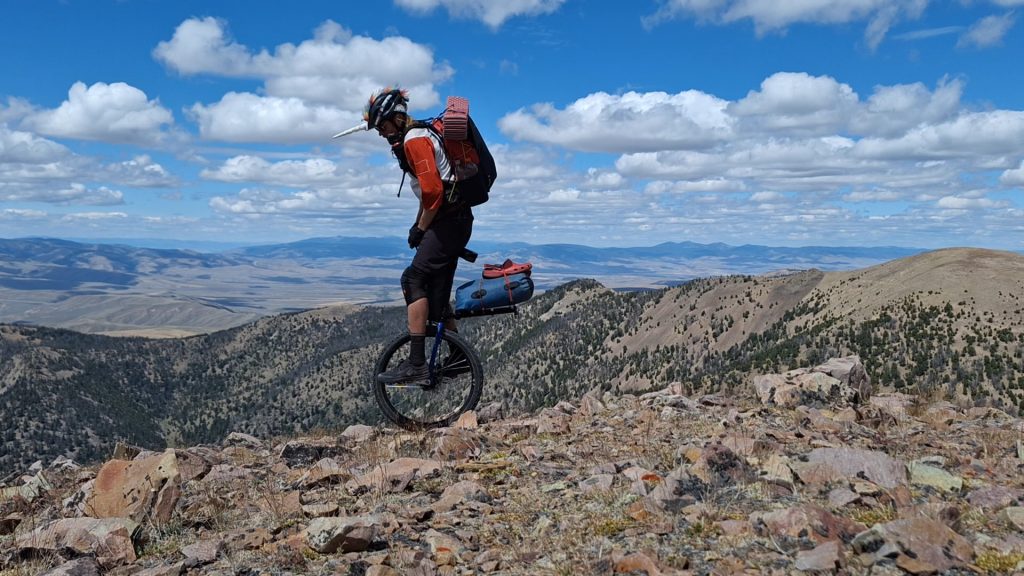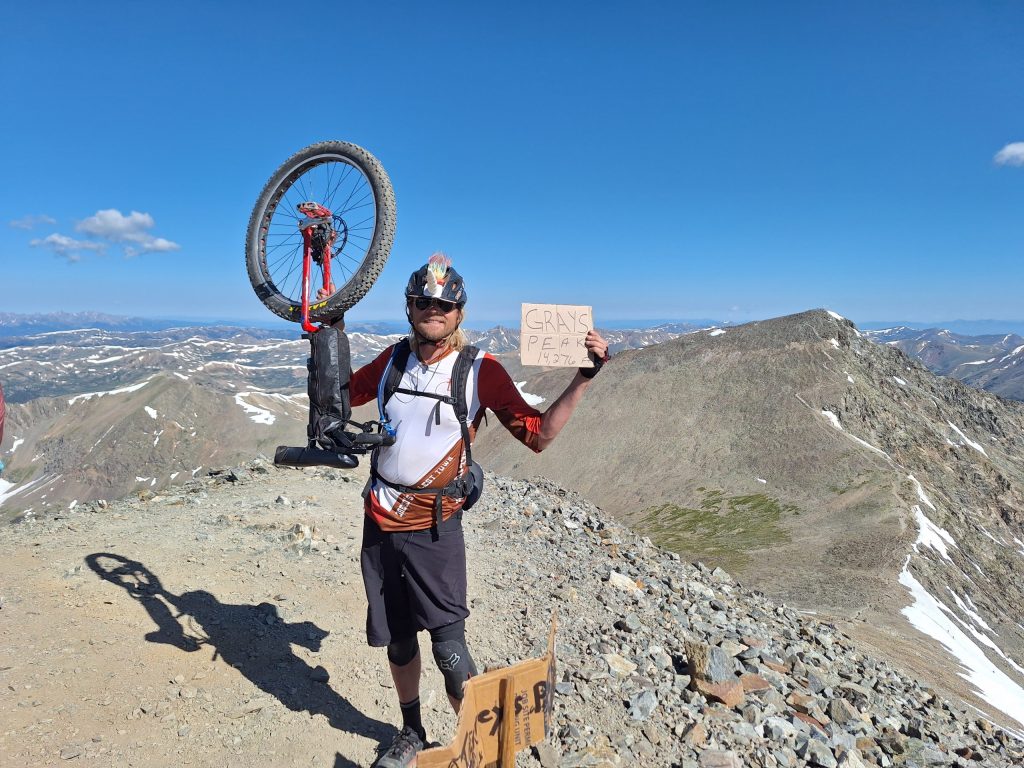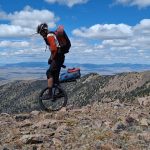To work through the death of his sister, a man unicycled hundreds of miles on the Continental Divide Trail
Jamey Mossengren bikepacked with his unicycle along one of America’s most challenging routes

Jamey Mossengren/Courtesy photo
Editor’s Note: This article contains references to suicide. To find help, call the Colorado Crisis Services hotline at 844-493-8255, or contact the National Suicide Prevention Lifeline by calling or texting 988. For life-threatening emergencies, call 911.
Everyone works through pain and grief in different ways.
To get through hard times, Jamey Mossengren sets off into the mountains with his unicycle, pedaling hundreds of miles along steep ridgelines, balanced on one wheel. The Minnesotan has “unipacked” — or backpacked with his unicycle — across the mountain West.
It all started a decade ago as a unique method of grieving. After a divorce, he set out on the Colorado Trail, a 567-mile-long path from Denver to Durango. It was his first-ever overnight camping trip of any kind. He said the three-week journey with his unicycle helped him “learn to forgive.”
This year, after his sister died by suicide, Mossengren found himself unipacking again. In June, he took to the Continental Divide Trail, a 3,100-mile-long trail that starts at the United States border with Mexico in New Mexico and ends at the Canada border in Montana, passing through Colorado and Wyoming along the way.

The Continental Divide Trail is considered to be among the most challenging hikes in the U.S., since the trail sustains incomplete sections and gaps between its single-track route and traverses both deserts and mountains. Mossengren had done about half the trail with some friends two years ago, but too work through his grief he decided to complete the remaining sections — this time with his unicycle.
The journey pushed Mossengren to his physical and emotional limits, but he said that he discovered forgiveness, beauty and joy along the way. He spent 53 days on the trail, traveling 1,200 miles, much of it on his unicycle.
“I won’t say I’m 100% healed, and I probably never will be,” he said, “but it took those two months being in the mountains and seeing the stars and just the beauty of this world to heal some of the cracks in my heart that were broken from what happened.”
Losing a loved one
Growing up in Minnesota, Mossengren was close with his sister, Amy, who was two years younger than him. After he graduated from college with an engineering degree, he and Amy bought a house together and lived as roommates for a number of years.
During that time, Mossengren was working at a medical company, but he soon realized that he wasn’t cut out for a desk job. He would find his true calling in a hobby he had learned at a young age: unicycling.
“I just hated it. I was in a small cubicle, Monday through Friday, 9 to 5, with little vacation. I’m like ‘Oh, this sucks. I gotta do this for 40 years? No, thank you,'” Mossengren said. “So after four years, I quit and moved to California and saw a street performer and thought, ‘That’s what I want to do.'”
For the last 18 years, Mossengren has performed under the name “The Unicycling Unicorn.” His act includes juggling and performing stunts on a unicycle that is usually dressed up as a unicorn. He has competed in the World Unicycling Championships and holds the official Guinness World Record for having ridden the tallest rideable unicycle, at nearly 44 feet. For many years, he has spent much of his time on tour, performing in Australia and Europe as well as the U.S.
The last time Mossengren saw his sister was last Christmas, when Mossengren was home in Minnesota visiting family. He described Amy as “a beautiful person.”
Mossengren continued performing for a few months after his sister’s death, but he said he was struggling to put on a smile for the customers. By June, he quit, instead taking his unicycle to the Continental Divide Trail, worried that he might never perform again.
“I love making people laugh and smile, but I was having a hard time going back to work because I was so sad and so broken inside,” he said. “It’s really hard to make someone else laugh and smile when you’re not happy yourself.”
Discovering the ‘love of the universe’
Especially during his first two weeks on the Continental Divide Trail, Mossengren said he cried a lot.
“I would just start thinking about everything,” he said, “but the more I pedaled, the more it kind of just lightened the load.”

Logistically, Mossengren had devised what he described as a “seven wheel system,” involving a Sprinter van, a moped and his unicycle, to be able to leapfrog across the Rocky Mountains. He would park the van at one trailhead, drive the “regular-old moped” down a rugged 4×4 trail to another trailhead, before unicycling along the Continental Divide Trail back to the van. This also allowed him to leave the unicycle behind in the van through sections of the trail that passed wilderness areas, where wheels are not allowed.
Some days were harder than others — not only was Mossengren working through the loss of his sister, but the Continental Divide Trail can be grueling, with unrelenting climbs and little shelter from the elements. He had around 15 pounds of gear strapped to his unicycle, but due to the terrain, he often had to carry the vehicle, which weighed another 15 pounds itself, or push it over rocks.
“It was too overgrown to ride some sections, or too rocky, and I’d have to hike the uni. I’d be cussing and swearing, like ‘Why the F do I have this unicycle!’ And then I’d sleep on it,” Mossengren said. “The next day, it’d be like a 4,000-5,000-foot descent down this fun single track, and I’m just hooting and hollering like ‘This is awesome. So much fun. Totally worth it.’ Luckily, the good days outweighed the bad ones.”
Day by day, pedal by pedal, Mossengren said he felt himself heal.
Mossengren’s journey took him through the section of the Continental Divide Trail that crosses northern Colorado, near Breckenridge, Keystone, Winter Park and Steamboat. At Grays and Torreys — two popular 14,000-foot peaks on the Front Range that lie along the Continental Divide Trail — he said he ran into tons of people on the trail who stopped him to ask questions, bewildered by the fact that he planned to unicycle down.
On other parts of the trail in Colorado, he encountered solitude.
“I remember being in the San Juans and going for a swim at the end of the day in this ice-cold lake. The sun’s going down, and I have a campfire going and the stars come up. I see a couple of shooting stars,” he said. “There were just so many days and nights like that, where you’re just like the only human for miles and miles. You look up and you see shooting stars and you’re like, ‘Wow, like, I’m so lucky to be alive.’ It’s hard to describe. It’s just a magical moment and even though you’re sad, you just feel the love of the universe and nature healing.”
‘The finish line’

By the end of the summer, Mossengren had completed the remaining sections of the Continental Divide Trail: From Grants, New Mexico, up through Colorado’s San Juans. Then, the northern section of Colorado all the way to Rawlings, Wyoming, and into Yellowstone National Park, where he finished his trip.
Now, he has completed the entire trail, including hundreds of miles by unicycle, a feat he said few others have even thought to attempt.
“Getting to the finish line, it was just that amazing feeling of knowing you did it,” Mossengren said. “You accomplished something that you know no one’s probably ever attempted or even thought of before — to hike half of it and unicycle half of it.”
Upon completing the Continental Divide Trail, Mossengren donated $1,000 to the American Foundation for Suicide Prevention in honor of his sister.

Though he doesn’t expect most people to find solace on a unicycle, Mossengren said nature and the outdoors have something to offer for everyone, especially those who are struggling with mental health.
“If you’re going through a hard time, whether it’s a divorce or a breakup or a death, maybe go for a long hike. Maybe do a big trail, like the Appalachian Trail, or the Pacific Crest Trail. Or maybe start small,” he said. “Either way, it’ll change you, and it’ll help you deal with what you’re going through. I highly recommend using the mountains, using Mother Nature, to heal.”

Support Local Journalism

Support Local Journalism
Readers around Glenwood Springs and Garfield County make the Post Independent’s work possible. Your financial contribution supports our efforts to deliver quality, locally relevant journalism.
Now more than ever, your support is critical to help us keep our community informed about the evolving coronavirus pandemic and the impact it is having locally. Every contribution, however large or small, will make a difference.
Each donation will be used exclusively for the development and creation of increased news coverage.










